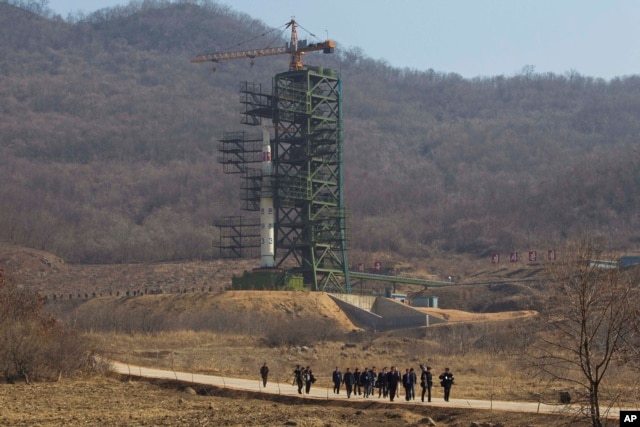December 08, 2015 12:03 AM
WASHINGTON—
U.S. experts warn that North Korea’s pursuit of a submarine-launched ballistic missile (SLBM) could pose serious security threats to the United States and its allies despite speculation that Pyongyang’s latest attempt to launch such a missile might have failed.
In May, North Korea conducted its first SLBM test and it appeared to be a success. Late last month, the communist country conducted another SLBM test, prompting military officials in Washington and Seoul to wonder if they should reassess Pyongyang’s missile program.
Recently, 38 North, a North Korea monitoring website run by John Hopkins University’s School of Advanced International Studies in Washington, released satellite imagery indicating Pyongyang appeared to be moving toward developing a submarine-launched ballistic missile.
What remains unclear is how close Pyongyang is to such a missile. Citing a government source, South Korea’s Yonhap News Agency reported North Korea’s second SLBM test ended in failure, with no indication that the missile successfully ejected from the vessel and took off.
But some U.S. experts are not sure if the test was indeed a failure.
“The North’s experience with SLBMs, especially this failure, seems to be more typical of a program they are actually working through, testing flaws in the missiles,” said Bruce Bennett, a senior defense analyst at the Rand Corporation, a global policy think tank.
“What we don’t know is what the nature of the failure was or how serious,” added Bennett.
Bennett called for efforts to deter such tests, saying “there is a high probability that North Korea will eventually have SLBM capability.”
FILE - A group of journalists walk down a road in front of North Korea's Unha-3 rocket at the Sohae Satellite Station in Tongchang-ri, North Korea.
Growing security threat
Bruce Bechtol, a professor at Angelo State University who specializes in security on the Korean peninsula, said North Korea’s effort to acquire SLBM capability might have started in the early 1990s, and Pyongyang could possess the capability much earlier than many experts previously predicted.
With SLBM capability, Pyongyang will have the ability to launch a missile attack on Hawaii, Bechtol warned.
David Maxwell, associate director of Georgetown University’s Center for Security Studies and the Security Studies Program, said the Pyongyang’s attempt to develop a submarine-launched ballistic missile shows its intent to continue to develop nuclear delivery capabilities.
“When fully operational, it [SLBM] could provide the regime with a second strike capability which would significantly enhance its deterrent capability if its land-based nuclear weapons were to be destroyed,” Maxwell said.
Last week, top nuclear envoys of Washington, Seoul and Tokyo reportedly agreed to work together to keep Pyongyang from conducting SLBM tests during their first trilateral meeting in nearly seven months.
The U.S. State Department expressed concerns over the North Korean move, citing U.N. sanctions that ban Pyongyang from conducting launches using ballistic missile technology.
Jee Abbey Lee contributed to this report, which was produced in collaboration with the VOA Korean service.
